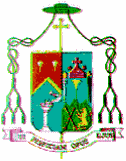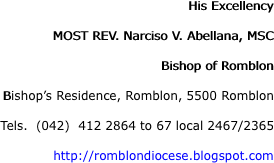The Catholic Bishops' Conference of the Philippines
The Official Website of
CBCP Online

On the economic side, the faithful of the diocese have come to realize that the time has come to give material and financial support for effective evangelization. The transition from arancel to the pledge system has brought encouraging results. After a period of massive campaign on information about the new system, monthly pledges of financial support have now started to come into the parishes. The faithful of the diocese are finally accepting the pledge system.
Part of the offering of the faithful—20 per cent of total, is to be allocated for the minister's share. This is supposed to provide the clergy with decent sustenance. To assist the pastors assigned in far-flung parishes, it has been decided that revenues for ministers' shares be pooled and apportioned equitably to all ministers of the diocese. This means richer parishes may be able to assist the poorer ones, and pastors working in all sectors of the diocese will enjoy equal ministers' shares.
The economic situation of the church in Romblon has improved considerably since the pledge system was introduced. From hereon the diocese hopes to move forward to the biblical tithing system.
The Social Action Center (SAC) assists primarily in the creation of parish-based cooperatives that cater to the socio-economic needs of poverty areas within a parish. At present there are 17 parish-based cooperatives in the diocese.
The Diocese of Romblon has 24 parishes manned by 30 priests and 1 religious SVD brother. The diocese is divided into 6 vicariates. It is a suffragan of the Archdiocese of Capiz. It covers a land area of 1,355 square kilometers and has a population of 227,621 of which 87 per cent are Catholics. Its titular patron is St. Joseph, spouse of the Blessed Virgin Mary, and its secondary patron is the Santo Niño.
The local church of the Diocese of Romblon has shown tremendous growth since its erection in April of 1974. Although the local situation is characterized by massive poverty because a majority of its people are poor fisher folk and marginalized farmers, the resources and strength of the Romblomanons, as the native inhabitants are called, have come to the fore to solve the vital problems that beset the diocese.
Romblon is a province composed of 20 islands and islets surrounded by deep waters in the Western Visayas region known as Region IV. Its three main islands – Tablas, Sibuyan and Romblon lie between the western tip of Panay Island and the end of the Bondoc Peninsula in Luzon. The Sibuyan Sea surrounds and separates them from the mainland of Luzon and the rest of the Visayas.
The earliest inhabitants of the province were the Negritos and the Mangyans of Mindoro. Thus its population comes from mixed stock—the seafaring Malays, the migrants from Luzon, and some Spanish and Chinese ancestors. Hiligaynon is the most widely spoken dialect.
The earliest historical data on Romblon comes from the historian Loarca, who visited Romblon in 1582. He wrote that Dutch warships and Muslim pirates often descended on the islands, killed all male inhabitants, and brought away all women and children for slaves.
In 1853 the colonial government of Spain organized Romblon into a politico-military command post, and made it a sub-province of Capiz. The islands remained part of Capiz until it became a regular province after 1946.
In the Diocese of Romblon today, a serious pastoral concern for the Christian faith is being given utmost priority. The increasing flow into the diocese of Fundamentalist groups and preachers has encouraged the clergy and the faithful to formulate programs for safeguarding the Catholic faith.
The formation of Basic Ecclesial Communities comes first among the support initiatives undertaken as a response to the threats against the faith. The Commission on the Laity, in coordination with the Diocesan Social Action Center assists in organizing faith communities that will work for poverty alleviation of poor parishioners.
The Pastoral Council of the Laity serves as an advisory body to the clergy in pastoral matters. The Organization of Lay Ministers plays its vital role in the parishes too. Because the members find ongoing formation a necessity, they attend weekly evangelization programs without fail.
|
Diocesan Curia |
|
Clergy |
|
Parishes |
|
Educational Center |
|
Institutions |
|
Statistics |

Diocese of Romblon

